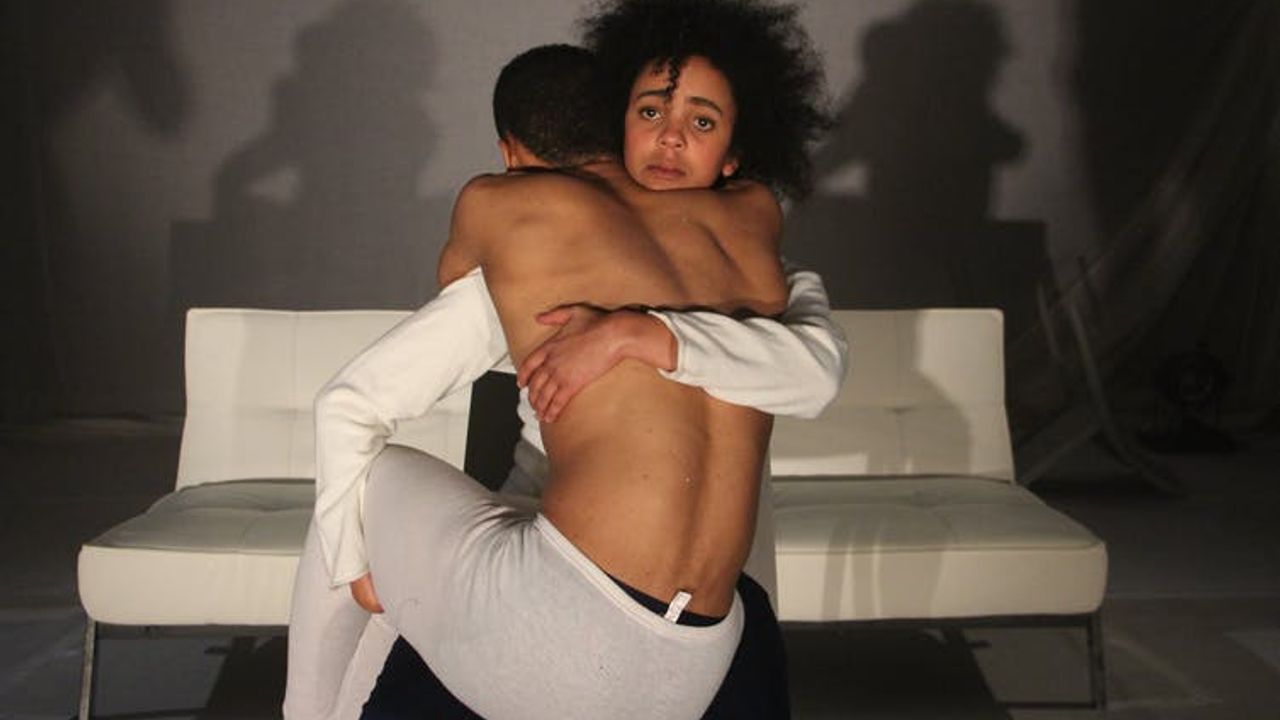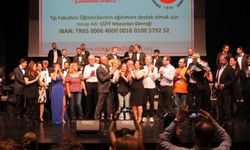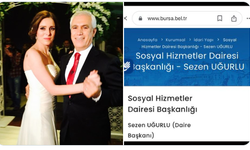Oyun ne hakkında?
Nadia Davids: What Remains , Cape Town'da bir köle mezarlığının beklenmedik bir şekilde ortaya çıkarılmasını, ardından arkeolojik kazıyı ve kölelik anılarının musallat olduğu bir şehri anlatan bir metin, dans ve hareketin birleşimidir . Kemikler yerden çıktığında, şehirdeki herkes - kölelerin soyundan gelenler , arkeologlar, vatandaşlar, mülk geliştiriciler - bazen hatırlanan, bazen unutulan bir tarihle hesaplaşmaya zorlanır.
Bu nedenle oyun , 2003 yılında bir kurumsal gayrimenkul geliştirmesinin ünlü bir on sekizinci yüzyıl mezarlığına çarptığı Prestwich Place'deki bir mezarlığın ortaya çıkarılmasını kurguluyor - güney yarımkürede şimdiye kadar ortaya çıkarılan en büyük mezarlardan biri. Köleleştirilmiş çamaşırcı kadınların çocukları olan sadece birkaç haftalık bebeklerden altmışlı yaşlarının sonlarında erkeklere kadar yaklaşık 3.000 ceset bulundu.
Dört figür - Arkeolog, Şifacı, Dansçı ve Öğrenci - kemikler ve kitaplar, arşivler ve delilik, tablolar ve protesto arasında hareket ederken, geçmişi şimdiyle uzlaştırmaya çalışırken.
Cape Town'un tarihi hakkında bize ne anlatıyor?
Nadia Davids: 2017'de yazdığım gibi , "Cape Town'daki tepki anında ve kutuplaştı: mülk geliştiriciler inşaata devam etmek istediler, miras yöneticileri ve arkeologlar kalıntıların bilimsel bir incelemesine öncelik verdiler (önemli veriler kemiklerden çıkarılabilir, maddi izler yanıtlar içeriyordu, arşiv araştırmalarındaki sinir bozucu boşluklar kapatılabilirdi), gömülü olanlardan soyundan geldiğini iddia eden topluluk aktivistlerinden oluşan bir ittifak, kemiklerin derhal yeniden gömülmesi konusunda ısrar etti.
(anlaşılır bir şekilde) kemikleri incelemenin, onları almanın, hayatta affedilmez bir gaddarlığa maruz kalmış bedenlere yeniden şiddet uygulamak olacağını hissettiler. "Mezarları soymayı bırakın!" ilk topluluk toplantılarından birinde biri bağırdı , diğeri, "Prestwich Street İlkokulu'nda okula gittim. Perili yerlerle büyüdük, perili topraklarda yaşadık. Orada mezarlıklar olduğunu biliyorduk. Şehre sorum nedir, bu nasıl oldu?”
Bu keşfin - terörün kanıtı ve buna verilen karmaşık tepkinin - kendi içinde ve ülkemiz için derin bir metafor olması beni etkiledi. Tarih, derinden çözülmemiş bir tarih, kelimenin tam anlamıyla yeryüzünden ortaya çıktı ve günümüzün bir konuşmasını talep etti - ve ondan gelen konuşma (ya da argüman) sermaye, hafıza, incinme, tarih, memur ve ihmal edilen arasındaki bir mücadeleydi. , nasıl hatırladığımız ve kime değer verdiğimiz. Hem kendi zamanına hem de acı verici bir şekilde bizim zamanımıza aitti.
Jay Pather'dan neden işbirliği yapmasını istedin?
Nadia Davids: Jay Pather parlak bir sanatçı - koreografisi zarif ve büyüleyici ama aynı zamanda politik, derinden hissedilen, imkansız derecede kesin, ülkemize ve acımasız tarihlerine dair derin bir anlayışla dolu. Yine de bir şekilde, her zaman umutlu, farklı, daha iyi bir gelecek hayal ediyor. Kalanlar'ı yazmaya ilk başladığımda bir roman yazdığımı sanıyordum. Belli bir noktada bunun canlılık, somutlaşma - toplu olarak, işbirliği, dolaysızlık gerektiren bir hikaye olduğunu fark ettim. Başka bir deyişle, bir roman değil, bir oyundu. Ve onu yönetecek kişinin Jay olduğunu biliyordum.
Metinle ona yaklaştım ve ilgilenmesi beni heyecanlandırdı. Tartışmalarımızın başında The Dancer karakterini eklemeyi önerdi. Metni kendi başına “koreografik” olarak anlamanın bir yolu olarak hareket ve dansla çalışmak istediğini ve Dansçı'nın hareketinin sadece canlandırmakla kalmayıp metne yanıt vereceğini ve anlatılmaz hikayeleri anlatacağını açıkladı. Bunun kesinlikle heyecan verici bir fikir olduğunu düşündüm.
Dansa ne katmayı umuyordun Jay?
Jay Pather: Nadia'nın metni özlü - ölçülü ve şiirsel ve yine de büyük tarihi olaylara ve geleceğimizle ilgili sorulara dayanıyor. Dans, metin tarafından yönlendirilen bundan kaynaklanmaktadır. Dolayısıyla eserde dans sadece “aralar” olarak mevcut değildir ve tüm musallatlara biçim veren belirlenmiş bir “dansçı” olsa bile, tüm aktörler hareket eder. Metin, sıradan ve büyük ölçekli dönemlerin içinde ve dışında kusursuz bir koreografi gibi zahmetsizce hareket eder. Harekete doymuş, yön ve koreografi bu ipucunu takip ediyor.
Metin zarfı iter mi?
Nadia Davids: Yayınlanan versiyonda, Jay ve ben oyun metinlerinin genellikle oluşturulma şeklini değiştirme fikri üzerinde çalışıyorduk. Dans ve hareketin sahnelenmesi ve çağrıştırıcı tanımları (adımlar değil) hakkındaki fikirleri dahil ederek türe aykırı bir şey yapmak istedik.

İzleyicilerden nasıl tepkiler aldınız?
Nadia Davids: İzleyiciler bu işe derinden yatırım yaptı – insanlar bizimle konuşmak için geride kaldılar, etkilendiler, öfkelendiler, rahatsız oldular, rahatladılar… Oyun 2016'daki ilk tekrarında Cape Town Üniversitesi'nde sahnelendi. 2017 yılında Grahamstown'daki Güney Afrika Ulusal Sanat Festivali'ne davet edildi. Bunu Cape Town'da bir başka koşu izledi ve ardından Hollanda'daki 2017 Afrovibes Festivali'nde sahnelendi. Neredeyse tüm performanslar satıldı.
Bazen bir eser beklenmedik bir akort eder, birçok kişi tarafından tutulan bir anı veya bir duyguyu ifade edebilir. Bu örnekte, hem yerel hem de küresel olarak, politik olarak çok tehlikeli bir anda olduğumuz duygusuyla birleştiğinde, köleleştirme, uzun süre haklarından mahrum bırakma ve şehir merkezine erişim konusunda eşzamanlı bir tarihsel hesaplaşma ihtiyacı.
Yayınlanan oyun Wits University Press'te mevcuttur
The award-winning play that touches hearts and nerves about Cape Town’s history of slavery
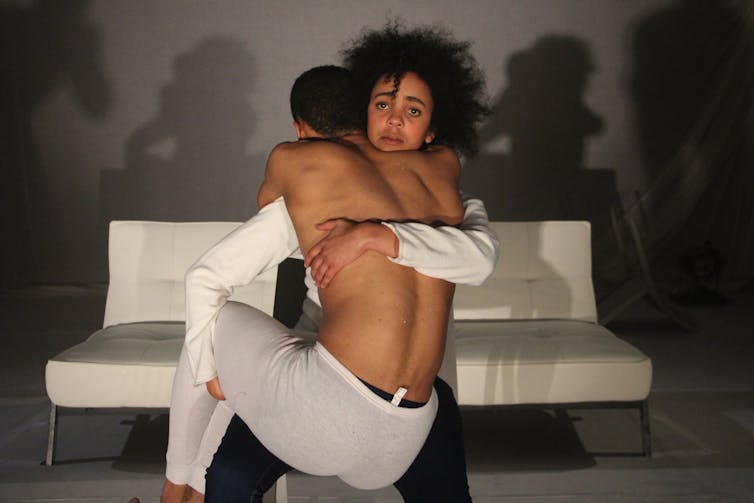
What Remains is one of the most successful South African plays of recent years. Written by Nadia Davids and directed and choreographed by Jay Pather, both artists and academics from the University of Cape Town, it has won numerous awards. Most recently Davids received the prestigious English Academy of Southern Africa Olive Schreiner Prize for Drama for the published text. We asked them about creating the work that shines a spotlight on South Africa’s history of enslaved people.
What is the play about?
Nadia Davids: What Remains is a fusion of text, dance and movement that tells a story about the unexpected uncovering of a slave burial ground in Cape Town, the archaeological dig that follows and a city haunted by the memory of slavery. When the bones emerge from the ground, everyone in the city – slave descendants, archaeologists, citizens, property developers – is forced to reckon with a history sometimes remembered, sometimes forgotten.
So the play fictionalises the uncovering of a graveyard at Prestwich Place where, in 2003, a corporate real estate development famously struck an eighteenth century burial ground – one of the largest ever to be unearthed in the southern hemisphere. Nearly 3,000 bodies were accounted for, from babies who were a just few weeks old – the children of enslaved washerwomen – to men in their late sixties.
Four figures – The Archaeologist, The Healer, The Dancer and The Student – move between bones and books, archives and madness, paintings and protest, as they struggle to reconcile the past with the now.
What does it tell us about Cape Town’s history?
Nadia Davids: As I wrote in 2017, “The response in Cape Town was immediate and polarised: the property developers wanted to continue building, heritage managers and archaeologists prioritised a scientific examination of the remains (important data could be drawn from the bones, the material traces held answers, frustrating gaps in archival research could be closed) while an alliance of community activists claiming descendancy from those buried insisted on the immediate reinterment of the bones.
They felt (understandably) that to examine the bones, to pick them over, would be to commit violence afresh on bodies that had in life been subjected to unforgivable cruelty. "Stop robbing the graves!” cried someone at one of the first community meetings, and another, “I went to school at Prestwich Street Primary School. We grew up with haunted places; we lived on haunted ground. We knew there were burial grounds there. My question to the City is, how did this happen?”
It struck me that this discovery – its evidence of terror and the complex response to it – was, in and of itself and a profound metaphor for our country. History, a deeply unresolved history, had literally emerged from the earth and demanded a present-day conversation – and the conversation (or the argument) that came of it was a struggle between capital, memory, hurt, history, the official, the neglected, how we remember and whom we cherish. It was both of its own time and, painfully, of ours.
Why did you ask Jay Pather to collaborate?
Nadia Davids: Jay Pather is a brilliant artist – his choreography is exquisite and captivating but it is also political, deeply felt, impossibly precise, full of a profound understanding of our country and its brutal histories. And yet somehow, it’s always hopeful, dreaming about a different, better future. When I first started writing What Remains I thought I was writing a novella. At a certain point I realised that this was a story that needed liveness, embodiment – collectively, collaboration, immediacy. In other words, it was a play, not a novel. And I knew Jay was the person to direct it.
I approached him with the text and was thrilled that he was interested. Early in our discussions he suggested adding the character of The Dancer. He explained that he wanted to work with movement and dance as a means of understanding the text as “choreographic” in and of itself and that The Dancer’s movement’s would not just animate, but respond to the text and narrate the stories that were unspeakable. I thought this an absolutely electrifying idea.
What did you hope to add with dance, Jay?
Jay Pather: Nadia’s text is pithy – restrained and poetic and yet grounded in major historical events and questions about our future. The dance derives from this, prompted by the text. So dance in the work is not present just as “interludes” and even though there is a designated “dancer” who gives form to all the hauntings, all the actors move. The text moves effortlessly, like seamless choreography, in and out of the ordinary and large scale epochs. Saturated with movement, the direction and choreography follow that cue.
The text pushes the envelope?
Nadia Davids: In the published version, Jay and I were working with the idea of shifting how playtexts are usually created. We wanted to do something genre-bending by including ideas around the staging and evocative descriptions (not steps) of the dance and movement.
What responses have you had from audiences?
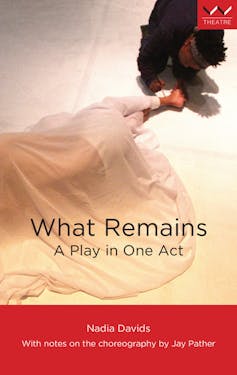
Nadia Davids: Audiences have been deeply invested in the work – people stayed behind to speak to us, they were moved, enraged, disturbed, comforted … In its first iteration in 2016 the play was staged at the University of Cape Town. In 2017 it was invited to the South African National Arts Festival in Grahamstown. Another run in Cape Town followed and then stagings at the 2017 Afrovibes Festival in the Netherlands. Almost all performances were sold out.
Sometimes a work strikes an unexpected chord, is able to articulate a moment or a feeling held by many. In this instance, a simultaneous need for historical reckoning around enslavement, long disenfranchisement and access to the city centre, coupled with a sense – both locally and globally – that we are in a very dangerous moment politically.
The published play is available at Wits University Press![]()
Nadia Davids, Associate Professor, University of Cape Town and Jay Pather, Professor, University of Cape Town
This article is republished from The Conversation under a Creative Commons license. Read the original article.
